
BESTMED DET-306 Infrared Forehead Thermometer Owner’s Manual

Introduction
The DET-306 infrared forehead thermometer is specifically designed for safe use on the forehead. The Infrared Forehead Thermometer is a device capable of measuring people’s body temperature by detecting the intensity of infrared light emitted from the forehead. It converts the measured heat into a temperature reading displayed on the LCD. Infrared Thermometer is intended for the intermittent measurement of human body temperature by people of all ages.
When properly used, it will quickly assess your temperature in an accurate manner.
 Please read all instructions carefully and thoroughly before using this product.
Please read all instructions carefully and thoroughly before using this product.
Warning:
- There is no gender or age limitation for using infrared forehead thermometer. This thermometer can be reused by many people.
- Use of this Forehead thermometer is not intended as a substitute for consultation with your physician.
- Do not allow children to take their temperatures unsupervised, some parts are small enough to be swallowed.
- Never immerse this device in water or other liquids(not waterproof).
- Do not modify this equipment without authorization of manufacturer.
- Do not expose the thermometer to temperature extremes (below -25°C/-13°F or over 55°C/131°F) nor excessive humidity (>95%RH).
- Keep the battery away from children.
- Remove battery from the device when not in operation for a long time.
Product Description
- Probe
- START Button
 Button
Button Button
Button- Battery Cover
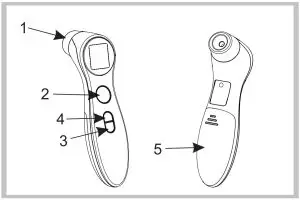
LCD Display Introduction
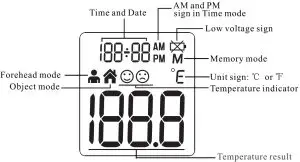
Basic Functions
| Real Time Clock | The real time clock will be recorded with the memory function and help you to recognize each measurement result. — Please see the Real time clock setting section to learn how to setup the time in the first use. |
| Forehead Mode | The thermometer has been designed for practical use. It’s not meant to replace a visit to the doctor. Please also remember to compare the measurement result to your regular body temperature. — Please see the Illustration For Use section to learn how to measure the body temperature. |
| Object Mode | The object mode shows the actual, unadjusted surface temperatures, which is different from the body temperature. It can help you to monitor if the object temperature is suitable for the baby or patient, for example the baby’s milk. — Please see the Illustration For Use section to learn how to measure the object temperature. |
| Beep Alarm | If thermometer detects a body temperature 37.8t(100.0°F) under forehead mode, there will be a long beep sound followed by three short beep sound to warn the user. |
| Memory Mode | There are each 10 sets memories for forehead and object measurements. Each memory also records the measurement date/time/mode icon. |
| °C/ °F Switch | Please see the Selecting A Temperature Scale section to learn how to change between Celsius and Fahrenheit. |
Forehead Thermometer Advantages
Infrared Forehead Thermometer measures core body temperature, which is the temperature of a body’s vital organs. (See Figure 0 This thermometer is designed to measure the temperature of the skin surface over the temporal artery, a major artery of the head. The temporal artery is connected to the heart via the carotid artery, directly leading from the aorta, the main trunk of the arterial system. It offers constant blood flow. Therefore, body temperature changes are reflected sooner in the forehead than they are in other parts of the body such as oral, rectal and underarm. Vital Organs

Figure 1
Real Time Clock Setting
When using thermometer for the first time, please set the parameters of the thermometer. With the thermometer off, press and hold  BUTTON to enter into setting mode for 3 seconds.
BUTTON to enter into setting mode for 3 seconds.
- Set the time format
The device can display the time in either an AM/PM (12-hour) or a 24:00(24-hour) format. Press and release START BUTTON to select the format. With the preferred time format on the display, press BUTTON, the Hour figure is flashing automatically.
BUTTON, the Hour figure is flashing automatically.

- Set the hour
Press and release the START BUTTON to advance one hour until the correct hour appears. After the hour is set, press BUTTON, the Minute figure is flashing automatically.
BUTTON, the Minute figure is flashing automatically.

- Set the minute
Press and release the START BUTTON to advance one minute until the correct minute appears. After the minute is set, press BUTTON, the Year figure is flashing automatically.
BUTTON, the Year figure is flashing automatically.
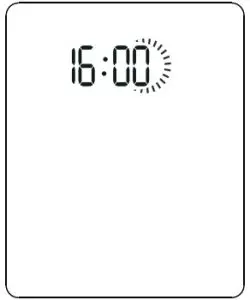
- Set the year
Press and release the START BUTTON to advance one year until the correct year appears. After the year is set, press BUTTON, the Month figure will appear.
BUTTON, the Month figure will appear.

- Set the month
Press and release the START BUTTON to advance one month until the correct month appears. After the month is set, press BUTTON, the Date figure is flashing automatically.
BUTTON, the Date figure is flashing automatically.

- Set the date
Press and release the START BUTTON to advance one day until the correct month appears. After the day is set, press BUTTON to exit the setting mode.
BUTTON to exit the setting mode.

Temperature Taking Hints
To ensure that the reading always reflects the body temperature accurately, you need to take account of the following factors which may affect an accurate reading.
- It is important to know each individual’s normal temperature when they are well. This is the only way to accurately diagnose a fever. To determine normal temperature, take multiple readings when healthy. Re-measure with a standard digital thermometer for confirmation.
- Users must be inside for 30 minutes before taking a measurement. Note: Users and the thermometer should be in the same ambient temperature for at least 10 minutes before taking a reading.
- Users should not drink, eat, or be physically active such as bathing, showering, shampooing and hair drying before/while taking the measurement. Remove hat and hair and wait 10 minutes before taking a reading.
- Oils or cosmetics on the forehead may give a lower temperature reading than the actual one. Remove dirt from the forehead before taking a measurement. Wait at least 10 minutes after washing the forehead area before taking a reading.
- Holding a hand on the forehead for any length of time will affect the temperature reading.
- Do not take temperature over scar tissue, open sores or abrasions.
- Do not use the thermometer on a perspiring or sweating forehead, as this may affect the reading.
- Don’t take a measurement while or immediately after nursing a baby.
- Do not use this thermometer outdoors.
- Do not take temperatures with this thermometer near places that are very hot, such as fireplaces and stoves.
- The probe window of the thermometer is the most delicate part of the device. Do not touch the probe window. The accuracy of the reading may be affected if the probe window is damaged or dirty.
- If the thermometer is stored in a significantly different environment than testing location, place it in the testing location for approximately 30 minutes prior to use.
- It is not intended for use in the oxygen rich environment or presence of flammable anesthetic mixture with air, oxygen or nitrous oxide.
Illustration For Use
To measure forehead temperature:
- Press the
 BUTTON, The display is activated to show all segments. After self-checking Figure 2 appears on the display screen with beeps, so you can start a new measurement.
BUTTON, The display is activated to show all segments. After self-checking Figure 2 appears on the display screen with beeps, so you can start a new measurement. - Aim the thermometer at the center of the forehead with a distance of 2 to 3 cm(See figure 3) and then press the START BUTTON.
Note: Do not remove the thermometer from the forehead before hearing the final beep. A waiting period of 3 seconds between testing is recommended to ensure complete accuracy. - Read the temperature on the display.
- Press the
 BUTTON to turn off.
BUTTON to turn off.


How to change the forehead mode and object mode:
You can press  BUTTON to switch the mode between Forehead mode and Object mode. IP.
BUTTON to switch the mode between Forehead mode and Object mode. IP.
To measure object temperature:
- Press the
 BUTTON to turn on the thermometer, you can take the object temperature after hearing two beep sounds.(see figure 4)
BUTTON to turn on the thermometer, you can take the object temperature after hearing two beep sounds.(see figure 4) - Aim the thermometer at the center of the object you want to measure with a distance of Ito 2 cm.
- Press the START BUTTON and then read the temperature on the display.
- Press the
 BUTTON to turn off.
BUTTON to turn off.

After measurement:
- Power off: Device will automatically shut off if left idle for more than 1 minute to extend battery life.
- Clean the probe after each use to ensure an accurate reading and avoid cross contamination. (See the section of Care and Cleaning for details.)
BackLight:
In Forehead mode:
- The display will be lighted GREEN for 3 seconds with a happy face
 when the unit is ready for measurement and a measurement is completed with a reading less than 37.3t(99.11″).
when the unit is ready for measurement and a measurement is completed with a reading less than 37.3t(99.11″). - The display will be lighted YELLOW for 3 seconds with a happy face
 when a measurement is completed with a reading less than 37.8t(I 00.0T).
when a measurement is completed with a reading less than 37.8t(I 00.0T). - The display will be lighted RED for 3 seconds with a bad face
 when a measurement is completed with a reading equal to or higher than 37.8°C(100.01).
when a measurement is completed with a reading equal to or higher than 37.8°C(100.01).
Temperature indicator:
In Forehead mode:
- If the temperature reading is below 37.80 (100.0T) , a happy face
 will be displayed next to the reading.
will be displayed next to the reading. - If the temperature reading is 37.80 (100.0T) or above, a bad face
 will be displayed next to the reading.
will be displayed next to the reading.
Memory Mode
- The Memory Mode can be accessed ether in forehead mode or object mode: When the thermometer has been turned on and followed by Figure 2/4 or finished testing, press and hold the
 BUTTON for three seconds. The letter M will appear in the center right corner of the display. (See Figure 5)
BUTTON for three seconds. The letter M will appear in the center right corner of the display. (See Figure 5) - The thermometer will automatically memorize the last I0 temperature readings. Each memory also records the measurement date/time/mode icon. Each time the
 BUTTON is pressed, the screen displays past readings that correspond with a number 1-10. The number I reflects the most recent reading, while the number 10 reveals the oldest reading stored in memory.(See Figure 6)
BUTTON is pressed, the screen displays past readings that correspond with a number 1-10. The number I reflects the most recent reading, while the number 10 reveals the oldest reading stored in memory.(See Figure 6) - In the memory mode,
 mark or
mark or  mark always exist. The user can press the START BUTTON to take new measurements.
mark always exist. The user can press the START BUTTON to take new measurements.


Selecting A Temperature Scale
- Temperature readings are available in the Celsius (˚C) or Fahrenheit (˚F) scale.
- With the thermometer off, press and hold the START BUTTON for 3 seconds to enter into unit changing mode.
- Press and release START BUTTON to select the unit.
- When the preferred unit on the display, press
 BUTTON to exit the unit changing mode.
BUTTON to exit the unit changing mode.

Care And Cleaning
- The probe window must be kept clean, dry, and undamaged at all times to ensure accurate readings. The accuracy of temperature readings can be affected by damage to the probe window, or the presence of dirt. fingerprints, earwax. dust and other soiling compounds on the probe window. Degraded sensors can degrade performance or cause other problems.
- Periodic cleaning and disinfection of the device following in order to prevent patient cross infection. Please clean and disinfect the thermometer immediately after each use.
For cleaning:- Soak a clean soft cloth in drinking water, wring it out and then wipe the thermometer(including probe) no less than 3 times;
- Then use another clean soft cloth to wipe the residue water on thermometer:
- Put the thermometer in the original packaging.
For disinfection: - Soak a clean soft cloth in drinking water, wring it out and then wipe the thermometer(including probe) no less than 3 times:
- Then use another clean soft cloth to wipe the residue water on thermometer:
- Using a clean soft cloth dipped in 70% medical alcohol, wipe the probe 3 times. at least one minute for each time.
- Using a clean cotton swab dipped in 70% medical alcohol, wipe the sensor window 3 times:
- Wait at least 10 minutes to let the alcohol volatilization and then put the thermometer in the original packaging
- Use a soft, dry cloth to clean the thermometer display and exterior.
- The thermometer is not waterproof. Do not submerge the unit in water when cleaning.
- Store the thermometer in a dry location, free from dust and contamination and away from direct sunlight.
- Strong electromagnetic fields may interfere with the proper operation oldie thermometer. The device needs special pre-cautions regarding EMC according to the EMC information.
- Put the thermometer back to the original packaging after using.
Battery Replacement
- Replace battery when ”
 ” appears in the upper right corner of LCD display. (See Figure 8)
” appears in the upper right corner of LCD display. (See Figure 8)

- Slide battery cover down as shown in Figure 9.

- Remove battery and install 2 new AAA alkaline batteries as shown in Figure 10 .

- Slide battery cover back on.
Specifications
| Measuring range | Forehead mode: 34.0°C-43.0°C(93.2cF-109.4T) Object mode: Ot-100t(32T-212°F) |
| Measuring site | Forehead(Forehead Mode) |
| Reference body site | Oral (This thermometer converts the forehead temperature to display its “oral equivalent.”) |
| Operation mode | Forehead mode(Adjust mode) |
| Laboratory accuracy | Forehead mode: ±0.2°C (0.47) during 35.5°C-42.0°C (95.97-107.67) at 15°C-35°C (59.07-95.0°F) operating temperature range ±0.3°C (0.57) for other measuring and operating temperature range Object mode: ±4% or ±2°C(47) whichever is greater |
| Display resolution | 0.1°C or 0.17 |
| Measure time | Approximately 1 second |
| Operating temperature range: | 10°C-40°C(507-1047), 15%-85%RH, non-condensing Atmospheric Pressure : 700hPa – 1060hPa |
| Storage and transport temperature range | -25°C- 55°C (-137-1317), 15%-95%RH, non-condensing Atmospheric Pressure : 700hPa – 1060hPa |
| Clinical accuracy | Clinical bias: -0.09°C (-0.16°F) Clinical repeatability: 0.13°C (0.237) Limits of agreement: 0.87°C (1.57°F) |
| Shock | withstands drop of 3 feet |
| Dimension | 153*41*44mm |
| Weight | Approx.84grams(with batteries) |
| Battery | DC3V(2 X AAA battery) |
| Battery life | Approx. 1 year/6000 readings |
| Expected service life | Three years |
| Ingress protecting rating | IP22 |
Troubleshooting
| Error message | Problem | Solution |
 |
Measurement before thermometer is ready | Take a measurement until appears on the display. |
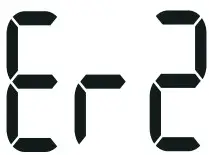 |
The ambient temperature is not within the range between l0’C and 40’C (50a’ 104T). | Place the thermometer in a room for at least 30 minutes at room temperature between l0V and 40‘C (50a 104s) |
 |
The thermometer is placed incorrectly or unsteady. | Read Illustration For Use thoroughly and take a new temperature measurement. |
 |
The thermometer showing a rapid ambient temperature change. | Allow the thermometer to rest in a room for at least 30 minutes at room temperature: between 10’C and 40’C (50T 104T) |
 |
The thermometer is not functioning properly. | Unload the battery, wait for 1 minute and repower it. If the message reappears, contact the retailer for service. |
 |
In Forehead mode: Temperature taken is higher than 43.0 V (109.4T). In Object mode: Temperature taken is higher than 100 V (212T). |
Read Temperature Taking Hints Thoroughly, then take a new temperature measurement. |
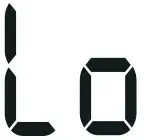 |
In Forehead mode: Temperature taken is lower than 34.0 ‘C (93.2T). In Object mode: Temperature taken is lower than 0‘C (32 -) |
Read Temperature Taking Hints thoroughly , then make sure the lens filter are clean, then take a new temperature measurement. |
 |
The thermometer could not work due to low battery. | Replace two new alkaline batteries size AAA. |
Calibration
The thermometer is initially calibrated at the time of manufacture. If the thermometer is used according to the use instruction, periodic readjustment is not required. However, We recommends checking calibration every two years or whenever clinical accuracy of the thermometer is in question. Please send the complete device to the dealers or manufacturer.
The above recommendations do not supersede the legal requirements. The user must always comply with legal requirements for the control of the measurement, functionality, and accuracy of the device which are required by the scope of relevant laws, directives or ordinances where the device is used.
A clinical summary and procedures for checking calibration are available upon request.(Turn on the thermometer and press the power button long time until entering into calibrate mode, software version will be displayed.)
ASTM laboratory accuracy requirements in the display range of 36.0 to 39.0 °C (96.8 to 102.2 °F) for IR thermometers is ±0.2°C(±0.4 °F), whereas formercury-in-glass and electronic thermometers, the requirement per ASTM Standards E 667-86 and E 1112-86 is ±0.1 °C(±0.2°F).”
 Type BF applied part
Type BF applied part Direct Current
Direct Current Disposal of this product and used batteries should be carried out in accordance with the national regulations for the disposal of electronic products
Disposal of this product and used batteries should be carried out in accordance with the national regulations for the disposal of electronic products Consult Accompanying Documents
Consult Accompanying Documents Batch Code
Batch Code Storage and Transportation Temperature Limit :
Storage and Transportation Temperature Limit :
-13 °F ∼ 13 1°F (-25°C ∼ 55°C
Service
The thermometer has a limited one year warranty. Do not attempt to disassemble or repair the thermometer by yourself. Should service be required during or after the warranty period you must contact the manufacturer. Repackage the thermometer carefully in its original packaging or securely pack to avoid damage during shipping. Include the original sales slip indicating the date of purchase, a note describing the problem, and your return address. Send the thermometer prepaid and insured. The lay operator or lay responsible organization should contact the manufacturer or the manufacturer’s representative: – for assistance, if needed, in setting up, using or maintaining the thermometer; or – to report unexpected operation or events.
Manufacturer:
JOYTECH HEALTHCARE CO. LTD. No.365,Wuzhou Road,Yuhang Economic Development Zone , 311100 Hangzhou China
Telephone: +86-571-81957767
Fax: +86-571-81957750 Made in China
Warranty
This appliance conforms to the following standards: ASTM E1965-98 Standard Specification for Infrared Thermometers for Intermittent Determination of Patient Temperature, ISO 80601-2-56 Medical electrical equipment —Part 2-56: Particular requirements for basic safety and essential performance of clinical thermometers for body temperature measurement, IEC 60601-I-II Medical electrical equipment —Part – 1 1 : General requirements for basic safety and essential performance -Collateral Standard: Requirements for medical electrical equipment and medical electrical systems used in the home healthcare environment and complies with the requirements of IEC 60601- I -2(EMC) , AAMI ANSI ES60601- I (Safety) standards. And the manufacturer is ISO 13485 certified.
Thermometer is warranted by manufacture to be free from defects in material and workmanship under normal use and service for a period of one year from the date of delivery to the first user who purchases the instrument. This warranty does not cover batteries, damage to the probe window, or damage to the instrument caused by misuse, negligence or accident, and extends to only to the first purchaser of the product.
FCC Information
Caution: Changes or modifications to this unit not expressly approved by the party responsible for compliance could void the user authority to operate the equipment.
Note: This equipment has been tested and found to comply with the limits for a Class B digital device, pursuant to Part 15 of the FCC Rules. These limits are designed to provide reasonable protection against harmful interference in a residential installation. This equipment generates, uses, and can radiate radio frequency energy. If this equipment does cause harmful interference to radio or television reception, which can be determined by turning the equipment off and on, the user is encouraged to try and correct the interference by one or more of the following measures:
- Reorient or relocate the receiving antenna.
- Increase the distance between the equipment and the receiver.
- Connect the equipment to an outlet on a circuit different from that to which the receiver is connected.
- Consult the dealer or an experienced radio/TV technician for help.
Electromagnetic Compatibility Information
The device satisfies the EMC requirements of the international standard IEC 60601-1-2. The requirements are satisfied under the conditions described in the table below. The device is an electrical medical product and is subject to special precautionary measures with regard to EMC which must be published in the instructions for use. Portable and mobile HF communications equipment can affect the device. Use of the unit in conjunction with non-approved accessories can affect the device negatively and alter the electromagnetic compatibility. The device should not be used directly adjacent to or between other electrical equipment.
Table 1
| Guidance and declaration of manufacturer-electromagnetic emissions | ||
| The device is intended for use in the electromagnetic environment specified below. The customer or the user of the device should assure that it is used in such an environment. |
||
| Emissions test | Compliance | Electromagnetic environment-guidance |
| RF emissions CISPR 11 | Group 1 | The device uses RF energy only for its internal function. Therefore, its emissions are very low and are not likely to cause any interference in nearby electronic equipment. |
| RF emissions CISPR 1 1 | Class 13 | The device is suitable for use in all establishments, including domestic establishments and those directly connected to the public low-voltage power supply network that supplies buildings used for domestic purposes. |
| Harmonic emissions IEC 61000-3-2 |
N/A | |
| Voltage fluctuations/ flicker emissions IEC 61000-3-3 |
N | |
Warning:
- The Use of this equipment adjacent to or stacked with other equipment should be avoided because it could result in improper operation. If such use is necessary, this equipment and the other equipment should be observed to verify that they are operating normally.)
- Portable RF communications equipment (including peripherals such as antenna cables and external antennas) should be used no closer than 30 cm (12 inches) to any part of the [ME EQUIPMENT or ME SYSTEM], including cables specified by the manufacturer. Otherwise, degradation of the performance of this equipment could result.
Table 2
| Guidance and declaration of manufacturer-electromagnetic immunity | |||
| The device is intended for use in the electromagnetic environment specified below. The customer or the user of the device should assure that it is used in such an environment. |
|||
| IMMUNITY test | IEC 60601 test level | Compliance level | Electromagnetic env ironm entguidance |
| Electrostatic discharge (ESD) IEC 61000-4-2 | ± 8 kV contact ±2 kV,±4 kV, ±8 kV, ±15 kV air |
± 8 kV contact ± 2 kV,±4 kV =8 kV, ±15 kV air |
Floors should be wood, concrete or ceramic tile. If floors are covered with synthetic material, the relative humidity should be at least 30 %. |
| Electrostatic transient/burst IEC 61000-4-4 | ± 2 kV for power supply lines 7+ 1 kV for Input/output lines |
N/A | |
| Surge IEC 61000-4-5 |
± 1 kV differential mode ± 2 kV common mode |
. | |
| Voltage dips, short interrupti- ons and voltage variations on power supply input lines IEC 61000-4-11 |
< 5% UT (>95% dip in UT) for 0.5 cycle 40% UT (60% dip in UT) for 5 cycle 70% UT (30% dip in UT) for 25 cycle <5% UT (>95% dip in UT i for 5 sec |
N A | |
| Power frequency (50/60 Hz) magnetic field I EC 61000-4-8 |
30 A/m | 10 III | Power frequency magnetic fields should be at levels charactertic of a typical location in a typical commercial or hospital environment. |
Table 3
| Guidance and declaration of manufacturer-electromagnetic immunity | |||
| The device is intended for use in the electromagnetic environment specified below. The customer or the user of the device should assure that it is used in such an environment. |
|||
| IMMUNITY test | IEC 60601 test level level |
Compliance | Electromagnetic environment guidance |
| Conducted RF IEC 61000-4-6 Radiated RF IEC 61000- 4-3 RF Wireless Communication Equipment IEC 61000- 4-3 |
3 V 0.15MHz to 80 MHz 6V in ISM and amateur radio bands between 0.15MHz and 80 MHZ 80%AM at 1kHz 10 V/m 80 MHz to 2.7 GHz 380MHz, 27V fin 450MHz, 28V /m 710MHz,745 MHZ,780MHz 9V/m 810MHz,870 MHZ,930MHz 28V/m 1720MHz,1845 MHZ,1970MHz 28V/m 2450MHz, 28V /m 5240MHz,5500 MHZ,5785MHz 9VIm |
N/A 10 V/m 380MHz, 27V /m 450MHz, 28V in 710MHz,745 MHZ,780MHz 9V/m 810MHz,870 MHZ,930MHz 28V/m 1720MHz,1845 MHZ,1970MHz 28V/m 2450MHz, 28V 5240MHz,5500 MHZ,5785MHz 9V/m |
Portable and mobile RF communications equipment should be used no closer to any part of the device, including cables, than the recommended separation distance calculated from the equation applicable to the frequency of the transmitter. Recommended seperation distance 3.5 r d =1—iv P 80 MHz to 800 MHz El 7 , hPr- d =(-i 800 MHz to 2.7 Ghz El where P is the maximum output power rating of the transmitter in watts (W) according to the transmitter manufacturer and d is the recommended separation distance in metres (m). Field strengths from fixed RF transmitters, as determined by an electromagnetic site survey, a should be less than the compliance level in each frequency range. Interference may occur in the vicinity of equipment marked with the following symbol:  |
Table 4
| Recommended separation distances between portable and mobile RF communications equipment and the device |
| The device is intended for use in an electromagnetic environment in which radiated there fore disturbances are controlled. The customer or the user of the device can help prevent electromagnetic interference by maintaining a minimum distance between portable and mobile RF communications equipment (transmitters) and the device as recommended below, according to the maximum output power of the communications equipment. |
| Rated maximum output power of transmitter
W |
Separation distance according to frequency of transmitter m | |
| 80 MHz to 800 MHz | 800 MHz to 2.7 GHz | |
|
|
El | |
| 0.01 | 0.12 | 0.23 |
| 0.1 | 0.38 | 0.73 |
| 1 | 1. | 2. |
| 10 | 4. | 7. |
| 100 | 12 | 23 |
| For transmitters rated at a maximum output power not listed above, the recommended separation distance d in metres (in) can be estimated using the equation applicable to the frequency of the transmitter, where P is the maximum output power rating of the transmitter in watts (W) according to the transmitter manufacturer. NOTE I At 80 MHz and 800 MHz, the separation distance for the higer frequency range applies. NOTE 2 These guidelines may not apply in all situations. Electromagnetic propagation is affected by absorption and reflection from structures, objects and people. |
||